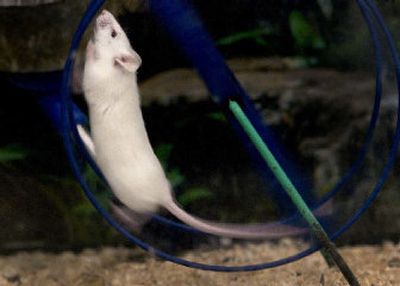Mice gain popularity as pets

Smart, sweet and fascinating to watch, mice are inexpensive, easy-care, enjoyable pets that are making a comeback.
“We’ve noticed an increase in the demand for specialty mouse products,” says Joe Fucini, a spokesman for the Pet Supplies “PLUS” chain of stores. “People of all ages are discovering just how charming these cute and intelligent little critters can be.”
Jeff San Souci of Hagen Pet Products has also noticed this burgeoning demand for all things mousy. “We’ve recently spent a lot of time developing new products exclusively for mice.”
Mice range from snake-food to “fancy” show-quality breeding stock, and vary in coat length, texture and color, not to mention markings. A big personality in a small package, a mouse only lives one to two years.
When selecting pet mice, look for alert, bright-eyed individuals that gently approach to sniff your fingers. Avoid sleepy mice with crusty eyes or ears or scruffy coats. The stool of healthy mice looks like formed pellets.
Mice are social animals and will become depressed if living alone. A couple of females sharing a cage will probably become fast friends, but avoid selecting two males especially from different litters. Males not only fight with each other, they give off a stronger urine odor, which is why females are more popular as pets. Don’t select a male and female unless you want up to 12 pink, blind babies within about 3 weeks. Once male and female are 6 to 8 weeks old, they can breed. Mice begin solid food at 2 weeks of age, and wean at 4 weeks of age. It’s best to handle mice early and adopt them by 8 weeks of age to develop a gentle personality.
Eight great products for happy, healthy mice:
Room to roam: Mice need enough room to scamper about, away from drafts or direct sunlight. A 10-gallon aquarium tank with a securely fastened wire mesh lid works well, as does a wire cage with a solid floor – wire floors hurt the feet. For true mouse magnificence, you can’t beat the Habitrail Mini system, a scaled-down version of the popular modular Habitrail hamster home. Brightly colored, easy-to-clean components click together to provide a series of spaces for rest, play and exercise — there’s even a mouse outhouse.
Snug as a bug: Mice spend much of their time grooming and nesting. Wood shavings are cleaner than newspaper. Avoid cedar or scented pine as they have harmful toxins from aromatic resins that cause respiratory problems. Change the bedding completely once or twice a week.
Empty nester: Offer your mouse a small snug area that is “chew-safe” such as a inverted cut-out margarine container or oatmeal box or a pet-store product. Mice rarely soil their nest, so replace as needed.
No cheese please: Provide a lab block such as LM Animal Farms Classic Mouse and Rat Food or equivalent for 80 percent of your mouse’s diet. Give hamster pellets in small quantities or occasional tidbits of fruit or vegetables as a treat. Hand feed these treats but not through the cage as this encourages your mouse to bite at fingers. Give your mouse a hard bone or wood product that is safe to gnaw to keep teeth from growing too long. Clean out the food bowl daily.
Trick of the treats: Just like dogs love the sound of “cookie” and cats become ankle rubbers as soon as the treat drawer is opened, mice love to get treats like Hartz NutritionYogurt Soynut Surprise for small animals, a healthy and tasty treat that can be used as a training reward.
Drinking and thriving do mix: A gravity-fed water bottle with a sipper tube keeps water fresh and clean. Mice tend to tip and soil water bowls. Change the water daily and check regularly for signs of leakage.
Play ball: These intelligent, curious creatures need plenty of physical and mental stimulation. Select exercise wheels made of solid plastic, because open-runged hamster wheels will trap a mouse’s slender tail. Mix it up by adding empty toilet paper rolls, ladders and other climbers and tunnels. These powerful chewers can soon destroy their playthings, so San Souci advises using toys designed specifically for small rodents and checking them regularly for signs of splintering.
Taming of the shrew (OK, mouse): If handled regularly from a young age, mice become tame and friendly creatures. Some owners like to handle their pet in a bathtub – accidentally let loose in a room, a mouse can vanish without a trace in the blink of an eye. Get started by putting a small treat in your hand. Gently lift the mouse by the base (thick end) of the tail, placing it on your hand, remaining calm and quiet the whole time. Never grasp the end of the mouse’s delicate tail.
“If handled gently and cared for properly, mice make enjoyable, engaging and generally healthy pets,” says Robyn Hauser, a veterinarian for Banfield, The Pet Hospital of Vancouver, Wash. “A veterinary examination and discussion about proper care are good ways to start things out right for a new pet mouse. Correct housing and handling, a proper diet and frequent cage-bedding changes are important to help mice stay healthy and happy.”
There are many good reasons to consider adding a mouse to your house as a fun, social, low-maintenance pet. If at anytime, your mouse appears listless, eats poorly, has skin or coat problems, moves abnormally, seems to be losing weight or has a runny nose and eyes, consult your veterinarian.